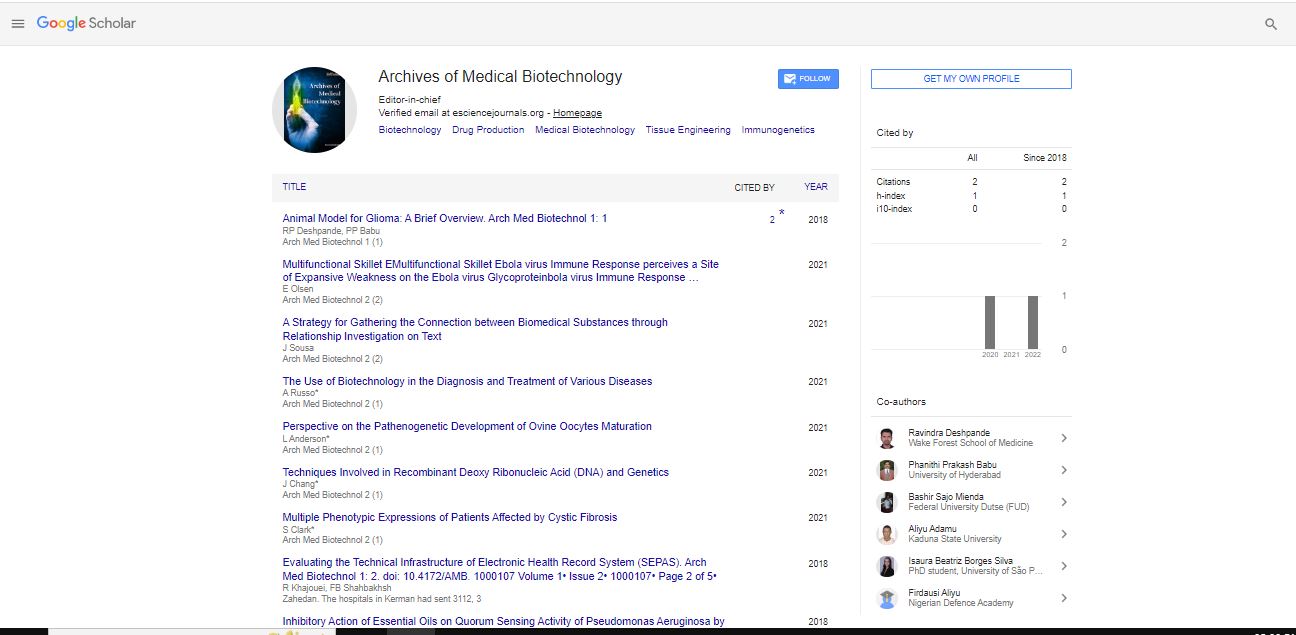Commentary, Arch Med Biotechnol Vol: 4 Issue: 2
CRISPR-Cas9: A Revolution in Precision Genetic Analysis
Ayu Abamu*
Department of Microbiology, Kaduna State University, Tafawa Balewa way, Kaduna, Nigeria
*Corresponding Author: Ayu Abamu,
Department of Microbiology, Kaduna State University, Tafawa Balewa way, Kaduna, Nigeria
E-mail: aabamu@ufu.ni
Received date: 22 May, 2023, Manuscript No. AMB-23-106355;
Editor assigned date: 24 May, 2023, PreQC No. AMB-23-106355 (PQ);
Reviewed date: 16 June, 2023, QC No. AMB-23-106355;
Revised date: 26 June, 2023, Manuscript No. AMB-23-106355 (R);
Published date: 03 July, 2023 DOI: 10.4172/amb.1000041.
Citation: Abamu A (2023) CRISPR-Cas9: A Revolution in Precision Genetic Analysis. Arch Med Biotechnol 4:2.
Abstract
CRISPR-Cas9 has emerged as a revolutionary gene editing tool with immense potential in medical biotechnology. This manuscript provides a comprehensive overview of CRISPRCas9, discussing its principles, applications, and ethical considerations. It explores the components and mechanisms of the CRISPR-Cas9 system, highlighting its versatility in editing genetic material. The study explores CRISPR-Cas9's numerous uses, such as gene therapy, disease modeling, and agricultural biotechnology. Finally, it addresses the ethical implications and future prospects of CRISPR-Cas9 in shaping the field of genetic research and its impact on human health.
Keywords: Gene therapy; Medical biotechnology; CRISPRCas9;
RNA; Genetic diseases
Description
The rapid advancements in gene editing technologies and introduces CRISPR-Cas9 as a transformative tool. It highlights the potential of CRISPR-Cas9 in addressing genetic diseases, modifying organisms, and understanding fundamental biological processes.
CRISPR-Cas9 system
This section explains the components of the CRISPR-Cas9 system, including the guide RNA (gRNA) and the Cas9 enzyme. It describes the process of gRNA design, Cas9 protein structure, and the formation of the Cas9-gRNA complex. The mechanics of DNA recognition, target site binding, and double-strand break induction have been simplified for gene editing.
Applications in disease modeling
This section discusses how CRISPR-Cas9 has revolutionized disease modeling by enabling the creation of genetically modified cellular and animal models. It explores how CRISPR-Cas9 allows researchers to introduce disease-associated mutations and study their effects on cellular functions and disease progression. The importance of CRISPR-Cas9 in identifying novel targets for therapy and evaluating treatment options is overwhelming.
Gene therapy and human health
This section delves into the potential applications of CRISPR-Cas9 in gene therapy. It explores how CRISPR-Cas9 can be used to correct disease-causing mutations in human cells, providing a promising avenue for the treatment of genetic disorders. The advantages and disadvantages of ex vivo and in vivo gene editing techniques, as well as current developments in preclinical and clinical investigations, are all highlighted.
Agricultural biotechnology
This section explores the impact of CRISPR-Cas9 in agricultural biotechnology. It discusses how CRISPR-Cas9 can be used to engineer crops with desirable traits, such as increased yield, nutritional value, and resistance to pests or diseases. The manuscript also addresses the regulatory considerations and public acceptance of All of the regulatory issues and public opinion around CRISPR-created Genetically Modified Organisms (GMOs) are analyzed.
Ethical considerations
This section delves into the ethical implications of CRISPR-Cas9 technology. It discusses the concerns surrounding off-target effects, germline editing, and the potential for unintended consequences. The significance of responsible use, ethical guidelines, and ongoing discussions over the legal restrictions on gene editing are also emphasized.
Future perspectives
The conclusion highlights the remarkable impact of CRISPR-Cas9 on medical biotechnology and emphasizes the need for continued research and development. It discusses potential future advancements, such as epigenome editing, and advances in delivery systems. The manuscript concludes by expressing optimism about the potential of CRISPR-Cas9 to shape the future of genetic research and personalized medicine.
Conclusion
In summary, CRISPR-Cas9 has revolutionized the field of gene editing, offering unprecedented precision, efficiency, and versatility. Its applications in disease modeling, gene therapy, and agricultural biotechnology hold great promise for improving human health and addressing global challenges. However, ethical considerations must be carefully addressed to ensure responsible use and harness the full potential of this revolutionary tool. With continued advancements, CRISPR-Cas9 is poised to transform the field of genetic research and make significant contributions to healthcare and agriculture.
 Spanish
Spanish  Chinese
Chinese  Russian
Russian  German
German  French
French  Japanese
Japanese  Portuguese
Portuguese  Hindi
Hindi 